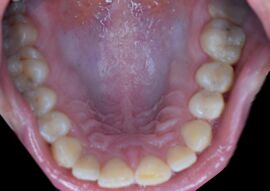Biology:Ruga (anatomy)
| Rugae | |
|---|---|
 Diagram from cancer.gov: Rugae can be seen within stomach. | |
| Anatomical terminology |

In anatomy, rugae are a series of ridges produced by folding of the wall of an organ.[1] Most commonly rugae refers to the gastric rugae of the internal surface of the stomach.
Function
A purpose of the gastric rugae is to allow for expansion of the stomach after the consumption of foods and liquids. This expansion result in greater surface area, thereby helpful in absorbing nutrients. It also increases volume of the stomach to hold large amount of food.
Location
Rugae can appear in the following locations in humans:
- Wrinkles of the scrotum
- Hard palate immediately behind the upper anterior teeth
- Inside the urinary bladder
- Vagina
- Gallbladder
- Inside the stomach
- Inside the rectum
Difference between rugae and plicae
Rugae are only evident when an organ or tissue is deflated or relaxed. For example, rugae are evident within the stomach when it is deflated. However, when the stomach distends, the rugae unfold to allow for the increase in volume. On the other hand, plicae remain folded regardless of distension as is evident within the plicae of the small intestine walls.
References
- ↑ Moore, Keith L; Dalley, Arthur F (2006). Clinically Orientated Anatomy (5 ed.). Philadelphia: Lippincott Williams & Wilkins. pp. 250.
ja:襞

